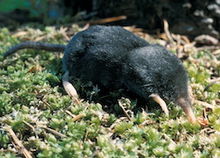American shrew-mole
| American shrew mole | |
|---|---|
 |
|
| Scientific classification | |
| Kingdom: | Animalia |
| Phylum: | Chordata |
| Class: | Mammalia |
| Order: | Eulipotyphla |
| Family: | Talpidae |
| Subfamily: | Talpinae |
| Tribe: | Neurotrichini |
| Genus: | Neurotrichus |
| Species: | N. gibbsii |
| Binomial name | |
|
Neurotrichus gibbsii (Baird, 1858) |
|
 |
|
| American shrew mole range | |
The American shrew mole (Neurotrichus gibbsii) is the smallest species of mole. It is the only living member of the genus Neurotrichus and the tribe Neurotrichini. It is also known as Gibb's shrew mole and least shrew mole. It is not closely related to the Asian shrew mole (Uropsilus in Urotrichini). The reason that it is called a "shrew mole" instead of being called either a "shrew" or a "mole" is because of its fur, which is a characteristic of shrews and its large head and heavy dentition, which is characteristic of moles.
It is found in damp, forested or bushy areas with deep, loose soils in the northwestern United States and southwestern British Columbia. In the most northern part of its habitat, it lives along streams or moist dense woods and in the most southern part of its habitat, it is found in swampy areas that are overgrown with vegetation such as sedges or shrubs.
Like shrews, it has a pelage with guard hairs and underfur. Its fur is dense and soft. The color ranges from dark gray to a sooty bluish-black. Its tail is about half the length of its head and body. Its tail is also covered with scales and scattered coarse hairs. It has a long, flattened snout, and a short but thick, bristled tail. It is the smallest of the American moles. It is about 10 cm (3.9 in) in length including a 3 centimetres (1.2 in) tail, and weighs about 10 g (0.35 oz). It has a zygoma and auditory bullae, which are absent in shrews, but present in moles. The enamel that covers its teeth is white instead of mahogany or reddish-brown, like it is in shrews. It also lacks a penis bone. Its front paws are smaller and do not face outwards from the body as in more fossorial moles, and so are more similar to those of shrews. The front paws are also broad with phalanges, which provide more support for the claws in order to dig. Also, the three middle claws of the front paws are elongated and the eyes are also completely covered by skin.
...
Wikipedia

